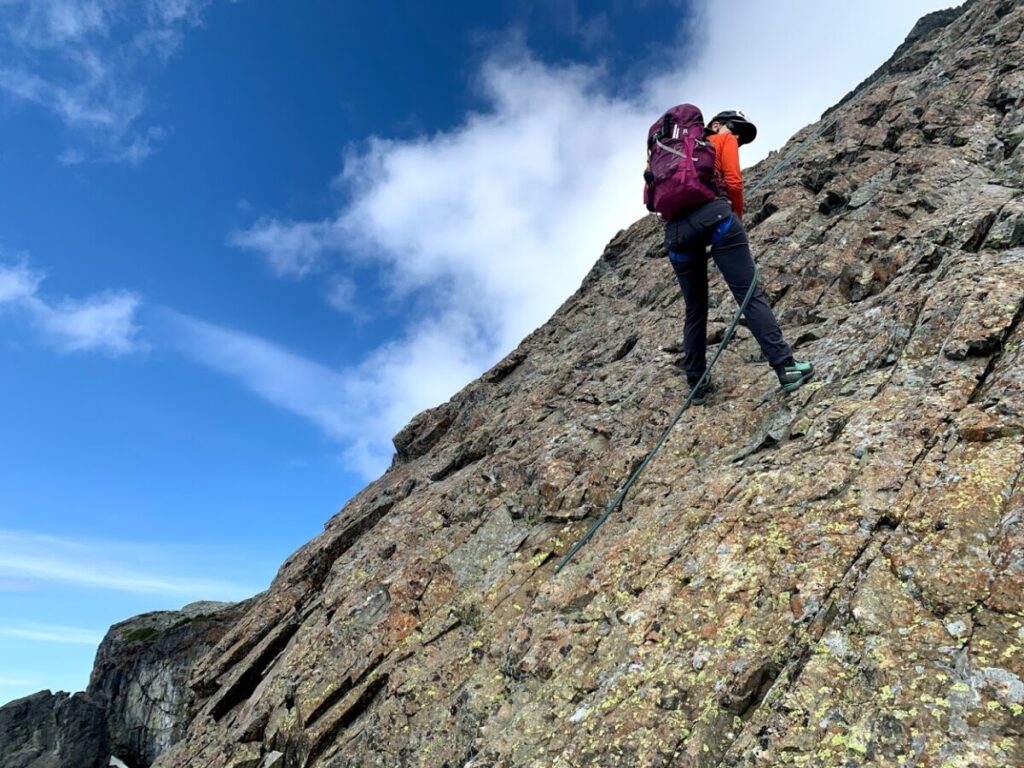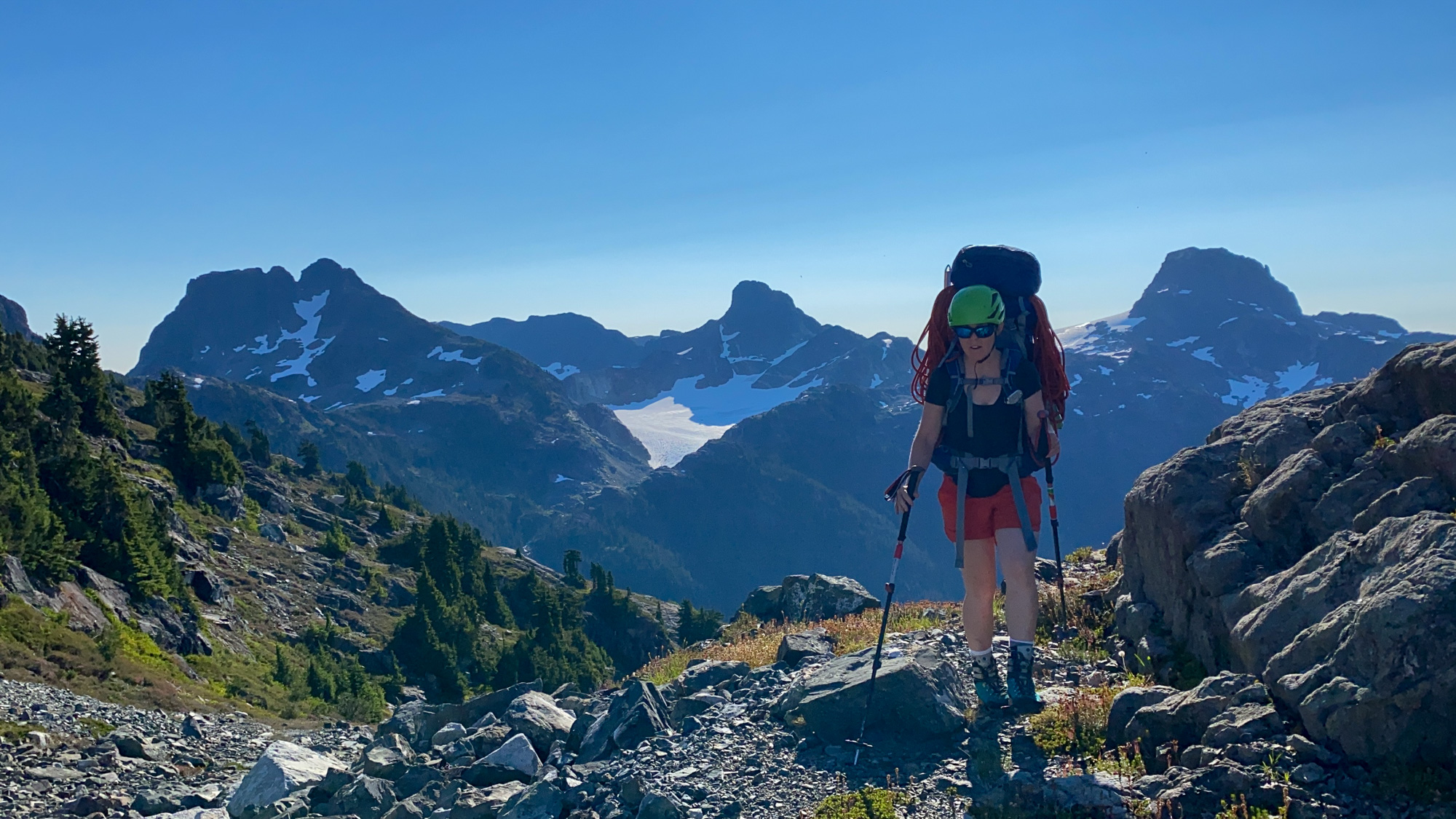We climbed Sky Pilot, our first South Coast summit at 2031 meters.
Easy access
You can skip the first few hours of arduous uphill hiking by taking the Sea to Sky gondola.

This was quite a different experience than climbing on Vancouver Island, where just the driving on old logging roads can take hours. And sometimes the driving can be as spicy as the climbing.

Some people probably feel like paying $50 per person to take a gondola is exorbitantly expensive. And it is expensive.
But 4×4 truck can cost more than a down payment on a home. Which means that few of us can afford a truck, except for those of us that are relatively wealthy. (And have some unusual priorities!)
In light of this, the $50 gondola ride leaving from the bus accessible parking lot suddenly seems a lot more reasonable.
And with easier access comes way more people. And with more people comes a lot of information and opinions about this route.
Hike, run, scramble or climb?

We were doing our research before we climbed, like we always do. And we read some conflicting things about Sky Pilot.
One website called it a “hiker’s mountaineering” trip. A Sky Pilot trail running race also comes up high in the search results. This made me think this mountain might be relatively easy.
However, the videos we watched of other people climbing seemed like this was a real mountain with dangerous terrain.
Usually I have information from very few sources before I set out on a Vancouver Island mountain. Perhaps a story from a friend. Maybe handful photos we find on Facebook. We photocopy route descriptions from the guidebook. Then off we go to take a look for ourselves.
It was surprising that more info led to more confusion. But we prepared expecting the worst and hoped for the best.
What we found
We got on one of the first rides up the mountain at 8:30. We set off a a decent pace, but were quickly passed by trail runners. They had on shorts, tank tops and tiny backpacks. A few had helmets or ice axes, but rarely both.

We had packed for a mountaineering day trip. We had boots, helmets, ice axes. harness and rope. We didn’t know if we would want to rappel or what the setup would be, so we had slings and other gear. Our backpacks stuffed with snacks, water and warm layers.
We kept reminding ourselves that the runners may not be going where we were going. But it was hard to fight off the flush of embarrassment at potentially being significantly over prepared.

The Pink Slab
We hit the most difficult part of the route, the Pink Slab. We had read online that some hikers may find this difficult but climbers will find the holds big enough.
When we arrived, we were a bit shocked. We saw a steep, tall wall with not great holds. The slab drop offs on either side. If you fell, you might tumble down the mountain.
There was nowhere to put any gear to protect from a fall. If we wanted to keep going, at least one of us would have to climb it without a rope aka free solo it.
We didn’t take any photos before we climbed. But here is a photo of me rappelling down it at the end of the day.

We stood there wondering what to do next when three trail runners popped up at the top. They were coming back down the Pink Slab. I watched in amazement as the first one scrambled his way down, and then just kept on running. Then came the second one came, as confident as the one before.
But the third runner, he was not as confident. His legs were shaking uncontrollably as he put his slippery running shoes on one hold and then the next. This leg shake was familiar to me as a climber. It is an involuntary response when you are terrified, exhausted and at the limit of your abilities.
Seeing how the runners approached it gave us more information about how we wanted to climb. So we decided to give it a go.
Both of us climbed it without ropes. The climbing actually wasn’t very hard. (… for us. It might be for you! I don’t know you!)
But it was the first time I attempted something so daunting that others had described as not difficult.
Erica and I are continuing to reflect and discus our decision to climb the Pink Slab. Sure, we had the physical ability to do this. But what was motivating us to climb? What impact did other people have on us? Was this the right decision?
The summit
We kept climbing, again a bit surprised to continue to see exposed and dangerous terrain. The climbing was well within our limits and experience level. But no hiker was just popping up here like it was no big deal.

When we made it to the summit, it was interesting to read that we were the third party to sign the register that day. Either many of the people who passed us chose not to sign, or they were indeed going somewhere else entirely.

The way home
It was supposed to be a long 18km day. But we were not going fast enough to catch the gondola down. We didn’t mind because we knew we could walk down and we don’t mind long walks in the dark.
There are two trails down. One is easy and long one. We took the shorter and steeper trail based on some not so great advice.
It turned out to be extremely challenging trail with exposed granite and rope hand lines you need to use to lower yourself down.

We should have taken the longer walk on the logging road. Or driven our truck up the logging road that we now know exists … and skipped the gondola all together!
Our day ended up being 26 km and taking us 12 hours, with quite a lot of that being the unplanned descent on the technical trail in the dark.
We are comfortable with long days in the mountains. We train so that 30 km days are not that challenging for us. And we are very used to travelling in the dark. So this did not pose any serious problems for us. Just wasn’t what we had hoped for!
Lessons learned
I feel very lucky to have learned to climb in the remote mountains on Vancouver Island. It’s taught me to be prepared for anything. Not just physically, but mentally as well. I’ve developed a mindset where I need to be pay attention my environment, how my partner is feeling and how I am feeling. I need to plan for long days and not expecting anyone to help me get unstuck. These are the things that keep me safer.
And when I do climb in places where there is so much information, so many people and easy access, I need to be way more discerning about who I listen to. And stay true to my roots. Be prepared for anything. And keep listening.
Discover more from We Belong Outside
Subscribe to get the latest posts sent to your email.




